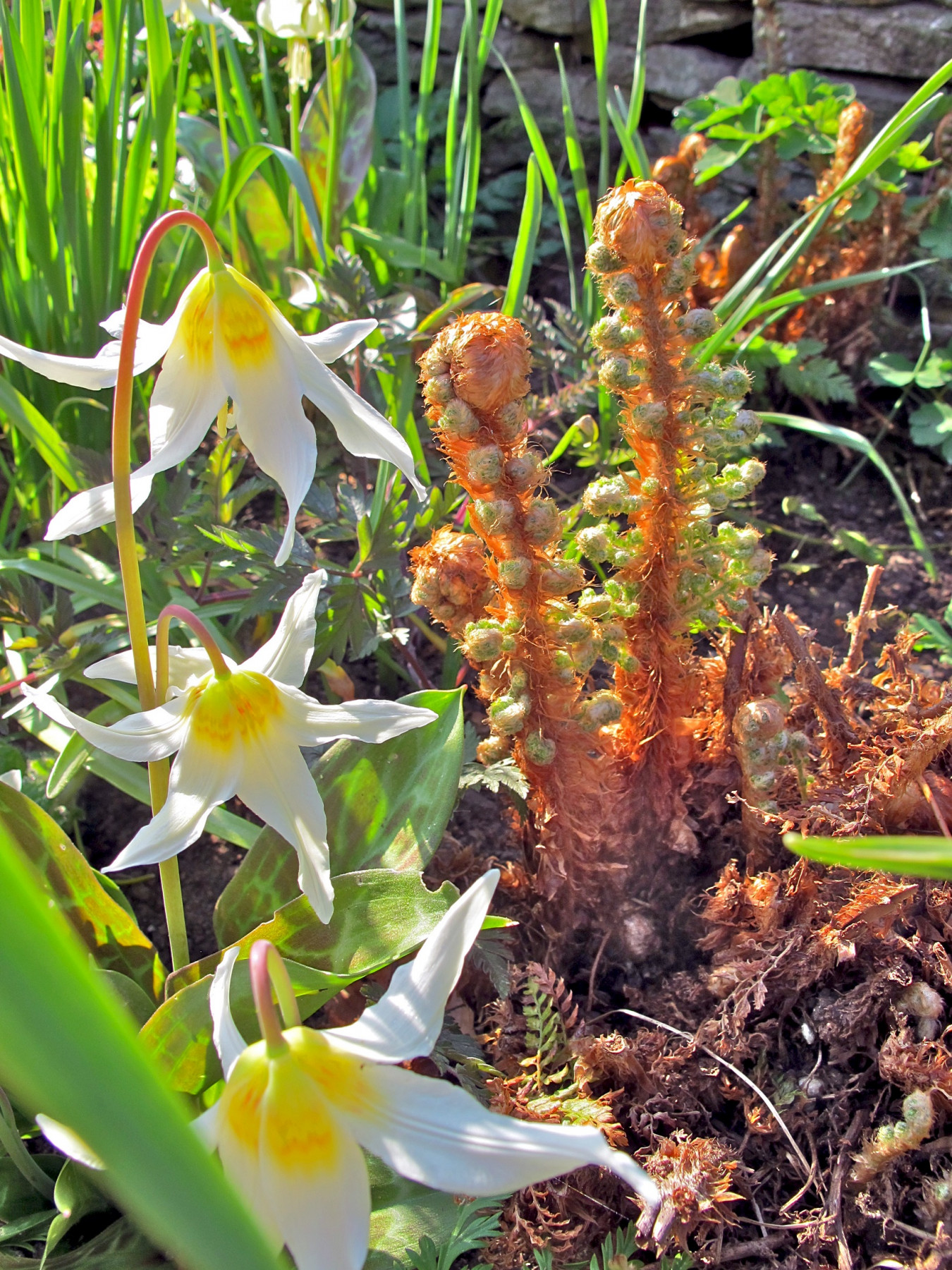
If there’s one plant that makes April special in my garden it’s Erythronium californicum ‘White Beauty’. The creamy flowers have six upturned petals that fly outwards to form a wide lily shape. Seen from above the petals display a cool hint of green as they meet the stem, catching the same glint of green found in the anthers suspended below the flower. Gaze inside and there’s a brown necklace of dots that tones with the handsome mottled foliage. It all goes to make ‘White Beauty’ a work of art and perhaps that level of visual perfection puts gardeners off, somehow indicating a ‘high maintenance’ plant. However ‘White Beauty’ is easy to grow as long as you find a cool, sheltered place ( away from strong winds) in dappled shade. It’s also as cheap as chips and, once planted, ‘White Beauty’ soon bulk sup. Each foot-high stem will bear three flowers, so it’s very showy from the first year onward.
Erythroniums are snow-melt plants in the wild, so they love a damp, cool spring. Conversely they can look miserably shrivelled in dry springs when temperatures rise too high, far too quickly. Consequently I find myself praying for a late, cool spring because then my erythronium flowers will be magnificent and long lasting. ‘White Beauty’ is a selected form of Erythronium californicum, a species found only in California in yellow pine forests on the chaparral, or on woodland edges. In my garden they often flower just as the polystichums, those rusty-bristled hardy ferns, unfurl their fronds. In cool springs, the two are freeze-framed and barely move. If it’s precociously warm the fronds, which look as though they’ve been crocheted, can unfurl in a day.
One common name for erythroniums is trout lily, because many have attractively mottled foliage rather similar to fish scales. This marked foliage emerges about four weeks before the flowers and adds much to a woodland patch. The bulbs are brittle and they do not have a protective skin so they scan nap easily if handled roughly. Take care when planting in autumn and when splitting up clumps after the flowers fade. Water them well before lifting and place your clump onto newspaper ,or a tarpaulin. Gently tease the bulbs apart and then, very carefully, replant single bulbs into friable soil that has been dug over really well. Adding garden compost or John Innes no 3 will help. Water the ground if it’s dry when replanting. It’s a time-consuming job that must be done carefully and I try to divide every third year to create swathes.
There are also strong yellows too. ‘Pagoda’ is a vigorous easily grown hybrid with lemon yellow flowers held above bronzed foliage. ‘Kondo’ has red-centred brighter yellow flowers and all-green foliage. Both are hybrids between E. tuolumnense and ‘White Beauty’ and both are easy and floriferous. Another hybrid, ‘Sundisk’, tends to have over-large green leaves and these can swamp the flowers. I took the ‘Sundisc’ out, too much leaf and not enough flower.
Erythroniums are also called Dog’s tooth violet. However this really applies to E. dens-canis, a six-inch high usually pink-flowered species found in Europe and Asia as far east as Japan. The small bulbs resemble canine teeth, hence the name. There are lots of named forms of this including ‘Frans Hals’, a violet-purple with a yellow ring at the throat, a blush-white called ‘Snowflake’ with blue anthers and ‘Lilac Wonder’. ‘Old Aberdeen’ is another pink form, again with blue anthers. These flower a couple of weeks earlier and their chocolate-blotched green leaves spread over the ground under swept-back pink flowers that resemble hardy cyclamen. They’re nowhere near as statuesque, but very charming. Edrom Nurseries ( www.edrom-nurseries.co.uk/ 01890 771386) have a good selection. This woodlander loves growing in leaf litter and, if happy, it will self-seed to form colonies. So far no seeds for me though!

If you want to see erythroniums in all their glory try to visit Greencombe in West Porlock in Somerset, the garden of the late Joan Loraine. It holds a well-labelled Plant Heritage collection and there are also collections of hardy ferns to admire. Joan travelled widely to look at erythroniums in 1998, 1999 and 2001, not bad for someone born in 1924! Her last plant-hunting trip was in her 80th year and she wrote a booklet entitled Hunting the Dog’s Tooth Violet. Miss Loraine researched the location of all the wild species and discovered that they encircled the northern hemisphere, growing between 50 and 35 degrees north. She then planted her erythroniums to reflect their geographical position in the world, with the help of botanist Brian Mathew’s precise information.
Joan’s north-facing garden, on the edge of the sea near Porlock in Somerset, is devoid of sun for much of the winter. As the days lengthen the sun begins to light up the garden once again, for a mere couple minutes on the first occasion. Miss Loraine once told me that she used to keep a bottle of sherry and a glass on the back doorstep to celebrate the return of the sunlight. She used to keep her sherry indoors. However by the time she managed to locate her glass and bottle it had often gone behind the hill again. I don’t drink, but I do appreciate the sentiment. Winters can be far too long for restless gardeners, just waiting for a warm day, although not too warm!
Greencombe Garden
Porlock
Somerset
TA24 8NU
www.greencombe.org / 01643 862363



